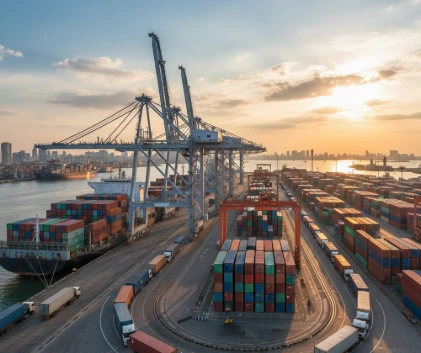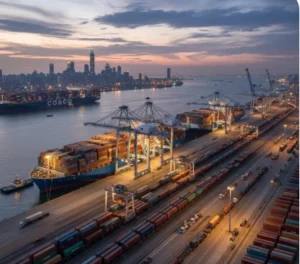Intermodal transportation is entering a decade of rapid worldwide expansion, driven by growing demand for logistics efficiency, mounting cost pressures, and the global shift toward more sustainable freight systems.
Intermodal transportation is entering a decade of rapid worldwide expansion, driven by growing demand for logistics efficiency, mounting cost pressures, and the global shift toward more sustainable freight systems. According to the report Intermodal Freight Transportation Market Forecast and Outlook 2025–2035, published by the international market intelligence firm Fact.MR, the sector is expected to reach USD 166.2 billion by 2035, nearly 3.1 times the estimated USD 54 billion in 2025. The projected 11.9% CAGR is unusually high for a traditionally conservative and asset-intensive industry such as freight logistics.
While the report highlights strong growth across emerging markets in Asia and Latin America, the United States stands out as one of the most influential engines behind global expansion. With a projected 12.2% CAGR through 2035, the U.S. is solidifying its position as one of the industry’s strategic hubs—supported by advanced rail infrastructure, high-volume cross-border trade corridors, and the rapid digitalization of its supply chain.

A Global Market in Transformation
Fact.MR’s analysis shows that intermodal transportation is undergoing a structural shift. Supply chains are moving away from single-mode transport models and migrating toward integrated multimodal networks that combine trucking, rail, inland waterways, and maritime transport. This transition is fueled by three core pressures:
• Lowering logistics costs in an inflationary environment.
• Improving reliability and achieving more predictable transit times, particularly for e-commerce, automotive supply chains, and agricultural products.
• Meeting environmental targets by increasing reliance on lower-emission modes such as rail.
The report notes that Asia-Pacific will lead global growth. India tops the projections with a 14.3% annual expansion, supported by industrial corridors and major rail modernization projects. China follows closely, with 13.1% growth driven by the Belt and Road Initiative, port automation, and booming e-commerce activity.
Europe also maintains a strong position. Germany is expected to lead the region by 2035 thanks to its highly integrated rail network, modern intermodal terminals, and consistently high operational efficiency—reaching a projected 12% CAGR.
United States: A Pillar of Global Intermodal Growth
While Asia is setting the pace for infrastructure investment, Fact.MR identifies the United States as a central pillar of the global intermodal market. The country’s market value is projected to grow from USD 13.8 billion in 2025 to USD 42.8 billion by 2035, propelled by four key drivers:
1. Surging Cross-Border Trade With Mexico and Canada
Under the USMCA framework, industrial flows among the three countries are reaching historic levels. Mexico’s nearshoring boom—combined with a resurgence in U.S. manufacturing—is fueling sustained demand for intermodal transportation, particularly along corridors such as Texas–Midwest, California–Mexico, and Great Lakes–Ontario.
2. Highly Competitive Rail Infrastructure
The United States operates one of the most extensive and efficient freight rail systems in the world, featuring:
widespread double-stack rail capability,
digitized and automated intermodal terminals,
and major operators like J.B. Hunt, FedEx Logistics, XPO Logistics, and C.H. Robinson, all cited by Fact.MR as dominant global players.
The road–rail segment, which will account for 45.8% of the global market in 2025, finds one of its strongest bases in the U.S., thanks to the long-distance efficiency of freight rail.
3. Rapid Digitalization Across the Supply Chain
Real-time visibility platforms, IoT devices, integrated tracking, and predictive analytics are transforming operations. According to Fact.MR, the U.S. leads the global adoption of automated systems in intermodal terminals—reducing dwell times, improving dispatch accuracy, and cutting operational costs.
4. Increasing Strain on the Trucking Sector
Driver shortages, rising fuel costs, and congestion along major highways such as I-5, I-10, and I-95 are pushing shippers toward rail-based intermodal alternatives. As a result, U.S. intermodal container volumes are growing at an annual rate of nearly 18%, particularly in retail, food distribution, and automotive supply chains.
Global Competition and an Industry in Reconfiguration
Fact.MR’s report shows a market composed of 30 to 50 significant players, where the top three—Oracle, C.H. Robinson, and DB Schenker—control between 25% and 30% of global share. Competition no longer revolves solely around pricing; reliability, network coverage, and technological capability are now decisive.
Another clear trend is the rise of the transportation & warehousing segment, projected to represent 35.6% of the market in 2025. Growth in this segment is driven by logistics outsourcing, warehouse automation, and the increasingly seamless integration between storage and multimodal transportation.
The U.S. Reinforces Its Strategic Weight in a Market Set to Triple
As global logistics face mounting pressures related to cost, speed, and sustainability, intermodal transportation is becoming essential for economic competitiveness. The Fact.MR report underscores that while Asia will drive much of the global expansion, the United States will remain one of the core pillars of worldwide intermodal growth—thanks to its infrastructure, commercial volume, and rapid technological adoption.
By 2035, the U.S. will not only maintain its leadership but will play a decisive role in shaping the evolution of the global intermodal market—an industry set to triple in size and fundamentally transform how freight moves across the world.

The U.S. Leads Global Growth in Intermodal Transportation
Intermodal transportation is entering a decade of rapid worldwide expansion, driven by growing demand for logistics efficiency, mounting cost pressures, and the global shift toward more sustainable freight systems.

California CDL Scandal Triggers 17,000 License Revocations After Federal Audit
California CDL Scandal Triggers 17,000 License Revocations After Federal Audit

Northern Lights Illuminate U.S. Highways and Surprise Nighttime Truckers
The Northern Lights dazzled drivers across the United States, painting the night sky in vivid colors from Minnesota to Alabama — a rare celestial show that turned ordinary highways into glowing horizons.

Operation Midway Blitz in Indiana leads to 146 truckers arrested
Operation Midway Blitz was carried out in coordination with the Indiana State Police, resulting in the arrest of 146 truck drivers. Raids conducted by the

Truckers for Troops: the trucking industry supports veterans
During Veterans Day, the trucking industry shows its support for active-duty service members and veterans. On November 11, we honor those who have served the

Cargo Theft: Why the Christmas Season Is the Most Critical Time of the Year
For the freight and logistics industry, Christmas brings enormous commercial opportunities—but also heightened exposure. Strengthening cargo security is not only a matter of technology or policing. It requires strategic planning, trained personnel, consistent internal protocols, and a culture of prevention.
